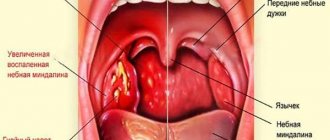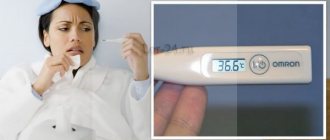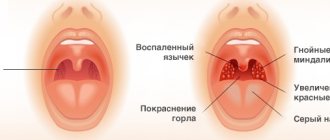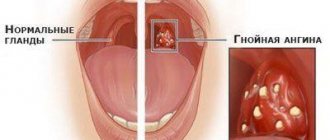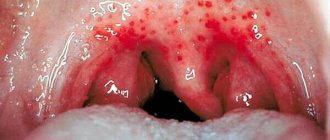Distinctive features of the disease
This pathology is associated with the development of an inflammatory process in the tonsils of the oropharynx. The cause of infection is streptococci, staphylococci and other bacteria. The development of the disease usually occurs against the background of an existing pathology of the upper respiratory tract, so most often angina occurs in people with ARVI and other diseases. The state of a person’s immunity also plays an important role.
The bacterial inflammatory process leads to the formation of a large amount of pus, which accumulates in the follicles of the tonsils. As a result, their surface becomes bright red, strewn with white or yellowish dots. This characteristic clinical picture allows an experienced doctor to make a diagnosis based only on examination of the patient’s throat.
As the pathological process progresses, the abscesses increase in size and can merge with each other. In advanced cases, the tonsils become covered with a whitish coating, which is easily removed with a spatula. This feature makes it possible to distinguish a sore throat from diphtheria.
Ways of infection with follicular sore throat
The infection can get to the mucous membrane of the tonsils both from the outside and from existing foci in the patient’s body. In the first case, microbes penetrate through airborne droplets or household contact.
In the second case, infectious agents can remain in the human body for a long period of time and not cause any symptoms. Most often, streptococci and staphylococci spread to the mucous membrane of the tonsils from teeth affected by caries. Therefore, to prevent sore throat, you should regularly visit the dentist and, if necessary, carry out treatment.
Symptoms
Most people, before the appearance of signs of follicular tonsillitis, first experience symptoms that are characteristic of any ARVI. There may be redness of the throat, discomfort when swallowing, hoarseness, cough, and a slight increase in body temperature. As the bacterial inflammatory process develops, the clinical picture becomes more severe.
Follicular tonsillitis is manifested by symptoms:
- sharp, pronounced pain in the throat, which becomes stronger when swallowing food. In some cases, the patient cannot eat at all because of this;
- redness of the mucous membrane of the tonsils, the presence of pus in their follicles;
- temperature rise to 39-40 degrees;
- increase in size, pain when touching the lymph nodes located under the lower jaw;
- signs of general intoxication of the body - decreased performance, weakness, discomfort in the joints;
- Possible indigestion, which is manifested by nausea, stool problems, and lack of appetite;
- pain in the heart area, increased heart rate, rhythm disturbances;
- in severe cases, with significantly severe fever, the child may develop neurological symptoms in the form of seizures and impaired consciousness.
In some cases, an atypical course of the disease is observed, when there is no increase in body temperature, which often indicates the presence of a more severe pathology in the patient. This variant of follicular sore throat occurs when:
- diseases of the endocrine system;
- autoimmune pathologies;
- a significant decrease in the body’s defenses due to HIV infection or taking certain medications;
- drinking large amounts of alcohol.
Follicular tonsillitis without fever occurs in people who take antibiotics for a long time and uncontrollably. The absence of fever is also typical for chronic forms of the disease.
How does a sore throat occur?
Inflammation of the tonsils is accompanied by the following symptoms:
- A sharp increase in temperature to 38-39 degrees.
- Severe pain when swallowing, which is not so pronounced with ordinary viral infections.
- Rapid development of the disease and deterioration in the first days of the disease.
- General intoxication (fever, vomiting, diarrhea, convulsions).
- Weakness and chills.
- Pain may occur when turning the head, which radiates to the ear area.
- The submandibular lymph nodes are enlarged and painful on palpation.
- A white-yellow coating appears on the tonsils and lacunae, which quickly reappears after removal.
- Unpleasant taste and odor in the mouth.
- Tearfulness and irritability in children.
- Possible indigestion, cramps and stomach pain.
How to diagnose
Making a diagnosis is usually not difficult. To do this, the doctor must find out the patient’s complaints, when they appeared, what they were associated with, and how they changed over time. After this, it is necessary to examine the tonsils. This is usually enough to make a diagnosis and determine the severity of the pathological process.
All patients are also prescribed laboratory tests, such as a general blood test. Its data makes it possible to more accurately determine the severity of inflammatory changes and the severity of the body’s response to the pathogen. In some cases, thanks to them, the doctor may suspect that the patient has a concomitant pathology of internal organs.
Before treating follicular tonsillitis, the doctor must also take a smear in the surface of the mucous membrane of the tonsils. This is necessary to determine the causative agent of the infection; the drug is selected depending on the cause of the disease. But since the results of a bacteriological study can only be obtained after 5-7 days, treatment is usually started immediately, based on which microorganism causes sore throat most often. These data are used when antibiotic therapy is ineffective in order to correctly change the treatment regimen.
Modern methods of treatment
Treatment of follicular tonsillitis in children and adults should be comprehensive. It includes measures aimed at destroying pathogenic microorganisms and reducing the severity of symptoms of the disease. Self-medication in this case can be not only ineffective, but also dangerous, since sore throat can lead to the development of severe complications. Therefore, only a doctor should select a treatment regimen.
The main role in the treatment of follicular tonsillitis is played by antibiotics with a wide spectrum of action. The use of these drugs helps stop the proliferation of pathogenic microbes. It is recommended to start taking these medications from the first day of illness, the course of treatment is 7-10 days.
Even in cases where the manifestations of the disease disappear on the second day after the start of antibiotic therapy, it is impossible to stop using these drugs, since the symptoms of follicular tonsillitis may reappear.
The most common antibacterial agents used for tonsillitis:
- Penicillin;
- Amoxiclav;
- Augmentin;
- Sumamed;
- Ceftriaxone;
- Ampicillin.
To speed up recovery, it is recommended to use not only antibiotics for follicular tonsillitis, but also locally acting antiseptics. Examples of such drugs are Miramistin, Chlorhexidine, Furacilin. These products should be used to gargle several times a day after meals. Such procedures help to destroy infectious agents from the surface of the tonsils, as well as remove pus.
Symptomatic therapy is primarily aimed at eliminating discomfort in the throat associated with the inflammatory process. For this purpose, medications are used in the form of sprays - Orasept, Miramistin, Kameton, Ingalipt. They not only soothe the inflamed mucous membrane of the tonsils, but also have a local antiseptic effect, enhancing the effect of antibiotics.
Treatment
If you have a severe sore throat, it is very important to seek medical help promptly. The doctor will be able to correctly determine the type of sore throat and prescribe effective treatment.
A neglected process can lead to intoxication of the entire body and give complications to other internal organs.
Possible development of tonsillopharyngitis, respiratory failure, convulsions, disruptions in the cardiovascular system, pulmonary inflammation, folliculitis (an infection of the hair follicles).
For a correct diagnosis, a visual examination is sufficient for an experienced doctor. A blood test and the result of a smear of throat mucus will help confirm it.
Treatment is aimed at:
- Elimination of the pathogen.
- Alleviation of the patient's condition and elimination of symptoms.
- Boosting immunity.
To prevent the spread of infection to other family members, the patient is given separate dishes and a towel.
Additional measures such as frequent ventilation and cleaning of the room, a light and vitamin-rich diet, and maintaining optimal humidity and temperature in the room will help speed up recovery. Considering the inflammation and pain in the throat, food for the patient should not be hot and preferably crushed.
Medicines used in the treatment of sore throat:
- Antibiotics or antifungals. The choice of a specific drug depends on the type of pathogen that caused the disease.
- Local antiseptics. Most often used in the form of rinses. This allows you to remove purulent plaque and speed up the healing of the mucous membrane. These can be drugs of synthetic or plant origin (decoction of sage, chamomile, calendula).
- Antihistamines. Used to relieve swelling and improve breathing.
- Antipyretic and anti-inflammatory drugs.
- Probiotics. Prescribed to prevent dysbiosis after antibiotic therapy and to eliminate disruptions in the gastrointestinal tract.
- Warming compresses or physiotherapy.
It is important to maintain bed rest, since a bacterial infection with a sore throat can spread to other organs and cause complications.
A sore throat can occur as an independent disease, but more often it is a complication of an acute respiratory viral infection that was not treated in time.
If the patient's condition does not improve on the fourth day of illness, at this stage it is very important to seek medical help in order to diagnose the disease in time, receive the correct treatment and prevent possible complications.
https://youtu.be/https://www.youtube.com/watch?v=pCKDHyLA8Pg
_
Traditional methods
Some folk methods can be used as symptomatic therapy. The following procedures have a good effect:
- gargling with a solution of soda or salt - it is recommended to use the product in a concentration of 1 teaspoon per glass of water;
- rinsing with decoctions of medicinal plants, for example, calendula, coltsfoot, sage, oak bark. They help reduce the severity of inflammatory changes in the throat and reduce discomfort;
- sucking honey with lemon - this remedy has a softening effect on the mucous membrane and also helps destroy pathogenic microbes.
Important! Follicular tonsillitis should be treated at home only after consulting a doctor. It is also important to remember that traditional methods play only a supporting role; without the use of medications, it is rarely possible to achieve recovery and prevent the transition of an acute pathological process to a chronic form.
What it is
The most common form of angina is follicular. Along with the traditional symptoms of sore throat and fever, it is characterized by an inflammatory process in the regional cervical lymph nodes due to swelling of the lymph adjacent to the lesions.
Follicular tonsillitis is often diagnosed in children and adolescents; in adults it is less common, and the older the person, the lower the likelihood of getting sick. Cases of the disease in people over 40 years of age are very rare. If an adult gets sick, it is only when he has chronic tonsillitis and its exacerbation occurs.
In case of illness at any age, it is important that treatment is carried out by a professional who will prescribe the correct antibiotics. The disease will have to be treated at home, but this does not mean doing it on your own, since only a qualified doctor can distinguish the pathology from herpes, purulent or lacunar tonsillitis.
Photo of what symptoms look like in the oral cavity
Features of the follicular type
With this type of angina, inflammation of the tonsils is observed with purulent manifestations in the form of symptoms of white spots. Since, along with infection of the mucous membrane, damage to the follicles also occurs, this form of the disease is called follicular tonsillitis. As the disease progresses and without adequate treatment, purulent follicles undergo connection and strengthening of the abscess.
The main symptoms are the presence of yellow-white spots on the surfaces of the tonsils, as it looks in the photo, shown in the article below.
ICD-10 code
The International Classification of Diseases uses the term “follicular tonsillitis” to designate a sore throat of the same name. The ICD-10 code is J8 .
Follicular sore throat in children
The clinical picture of tonsillitis in childhood is characterized by greater severity and rapid development. Typically, the maximum severity of clinical manifestations is observed on the second day after the onset of the disease.
Follicular tonsillitis in children can lead to the development of swelling of the oropharynx and breathing problems. This disease is often accompanied by the appearance of a skin rash, eye irritation, severe cough and runny nose.
Pregnancy and follicular tonsillitis
Follicular tonsillitis during pregnancy poses a serious danger to the body of the mother and the fetus. The disease can lead to premature termination of pregnancy. The cause of miscarriage is oxygen starvation, general intoxication of the body, and lack of vitamins. Therefore, treatment of sore throat should be carried out not at home, but strictly in a hospital, which allows timely detection of developmental anomalies.
The disease poses the greatest danger in the first trimester, when vital organs develop. Prescription of medications is inevitable. Modern medications do not have a strong effect on the fetus. Relatively safe antibiotics: macrolides, cephalosporin group. During pregnancy, it is contraindicated to reduce the temperature with acetylsalicylic acid. Only paracetamol-based products are allowed. A cool shower or a towel soaked in cold water, which is placed under the knees, will help alleviate the condition.
Why is follicular tonsillitis dangerous?
If the patient does not receive the necessary treatment, follicular tonsillitis can provoke the development of severe complications. They are associated with the spread of inflammation to internal organs: kidneys, cardiovascular system and joints. Sore throat caused by streptococci leads to the fact that the immune system begins to damage the cells of its “host”. As a result, a chronic inflammatory process develops in the myocardium, joints and kidneys, which is very difficult to treat.
Another danger of acute tonsillitis is associated with the possibility of transition to a chronic form of the pathological process. Because of this, it is important to diagnose and begin treating this disease as early as possible.
Follicular tonsillitis in adults and children is an inflammatory disease that often develops against the background of acute respiratory viral infections and other viral respiratory tract infections. Since it is associated with the action of bacterial flora, this pathology can only be cured with the help of antibiotics.
How to treat follicular sore throat
The main goal of treating tonsillitis of a purulent nature is to eliminate the inflammatory focus in the tonsils and nearby tissues. Chronic follicular tonsillitis is treated using the same means as the acute or catarrhal form. The main thing is to exclude relapses of the disease and stop the activation of pathogenic bodies. In addition to taking therapeutic drugs, you need to comply with the hospital regime.
Etiotropic therapy
For tonsillitis of bacterial etiology (usually streptococcal), antibacterial agents of a number of penicillins are used. If the patient has contraindications to this group, the other two series of drugs are prescribed. The most popular antibiotic is:
- Amoxicillin;
- Amoxiclav (penicillins);
- Erythromycin, Azithromycin (macrolides);
- Ceftriaxone (cephalosporins).
They contain not only amoxicillin, but also clavulanic acid, which enhances the effect of the first component. For tonsillitis of fungal etiology, antifungal agents are prescribed:
- Fluconazole;
- Itraconazole;
- Acyclovir;
- Tilorona.
Drugs with antiviral activity act in the first days of the disease.
Symptomatic drugs
To eliminate the infectious-allergic process, which often accompanies the manifestations of tonsillitis, anti-allergy medications and non-steroidal antihistamines are prescribed according to indications. The patient is prescribed general restorative therapy, including vitamins and immunomodulators. If complications arise from the heart and blood vessels, additional treatment is prescribed.
Local therapy
Gargling with antiseptic liquids is often used. They use solutions of furatsilin, hydrogen peroxide, and decoctions of medicinal herbs. Doctors advise carrying out physiotherapeutic procedures in order to enhance the therapeutic effect.
You should stick to your diet. In the first week, you should stay in bed, do not go outside, and limit physical activity. The patient's diet should consist of easily digestible foods and a healthy diet.
Chronic follicular tonsillitis requires longer treatment. On average, this process takes from 3 weeks to a month, sometimes longer. The sooner the patient deals with the elimination of the disease, the faster it will be possible to extinguish the inflammatory focus. Tonsillitis in an advanced form, during a period of calm, may not bother the patient and not make itself felt. The disease periodically recurs, especially after exposure to certain external factors: hypothermia, stress, poor nutrition. Often, acute or advanced tonsillitis is accompanied by a secondary infection. In this case, the healing process takes a longer time.
Follicular tonsillitis without fever is less common; the disease is accompanied by signs of classic tonsillitis, only without hyperthermia. As a rule, this phenomenon is inherent in the catarrhal form of the disease. It requires the same competent treatment, only without taking antipyretics. It is important to cure the disease in a timely manner, like its other forms; many patients do not take this nuance into account. They often confuse the illness with a cold, carry it on their feet and do not take any therapeutic measures. This behavior has disastrous consequences. The pathology passes into the acute phase, then into the chronic form. To promptly detect tonsillitis without fever, you need to conduct a visual examination of the throat cavity. If tonsils affected by inflammation are visible, the follicles are covered with pus - this indicates the presence of tonsillitis.
Methods of treating follicular tonsillitis.

